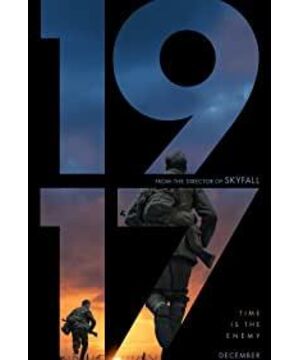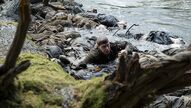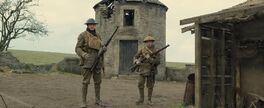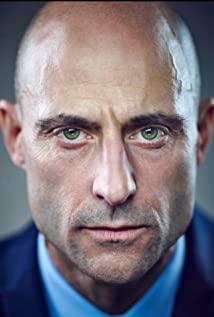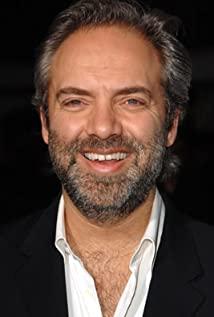On November 25, 2019, a war film "1917" that seemed nothing new appeared in the theater. Sure enough, only those who have seen it will be enthusiastic. The blockbuster introduced in China in December 2019 was postponed to July 7 a few days ago. In this half of the year, we have witnessed the brilliant achievements of this blockbuster: the 92nd Academy Awards in 2020 7 1 nominations, 3 awards, and the Golden Globe Award for best feature film, and other large and small awards. The last war movie that caught my eye and won a global award was "Hacksaw Ridge". The whole film is famous for its 109-minute "One Shot to the End", but it often overlooks the story of the hero's charge, except for the photography. The poetic grandeur is the lightning that runs in spring.
Introduction: In 1917, when the First World War entered the fiercest, two 16-year-old British soldiers received an order to rush to the death front and send a "stop offensive now" message to the generals there. Time is only eight hours, weapons and ammunition are limited, no one knows the situation of the enemy ahead: a place of death and silence, barbed wire full of corpses, sudden enemy troops, dangerous situations of death at any time... This time two teenagers are saving the lives of 1,600 people. , If you don't finish it, you'd better die! Director Sam Mendes, like Director Christopher Nolan, has used old-fashioned historical wars as themes in recent years, but they have been used as "test items". I have to say that the "Dun "Kirk" (my rating: four stars) is also an experiment with war films, but "Dunkirk" performed slightly worse. Putting aside the powerful sound and visual effects, Director Nolan follows absolute historical facts. This seems to have become a major drawback. There is no heroic charge, no humanity, and only a plain and boring running account plot. And "1917" was a great success, pursuing absolute novelty in photography: the whole film is shot to the end. Surrounded by scenery, people have an immersive experience, bringing the cruel visual impact of war. (Shooting new ideas is the number one)
First of all, let’s talk about the biggest highlight of "1917": one shot to the end. This is one of the few mirrors in the world at present. But this also symbolizes the overall look and feel of the film. Now let's take a look at the gains and losses of a mirror.
have to
The beginning of the chapter begins with the two protagonists resting on the grass, and then the journey of a mirror to the end. It is very reasonable and practical to use a mirror to the end to present such a clear goal and one-line forward plot line. The whole film is like a certain design. Appropriate game levels lead all personnel, with clear instructions on the map, tight time constraints and natural crises. The first half is precisely because of the sense of one direction advancement in the mirror, the audience no longer looks like a spectator, but explores the map from the perspective of the game, follows the protagonist through the crowd, walks through the barbed wire, and walks through the bunker. Walking through the sakura field...and in the second half, after a 20-second black screen transfer, the plot went to the second half. This is also the director’s expressive transfer: after the protagonist was fired, the black screen during this period left people with reveries. There was tension and hope (like the death of a game, looking forward to rebirth). The director began to cleverly use the sound. Empathy, the water drops gradually dripping, like awakening people from the air. So from this period, the role of the long lens entered the second half.
People are separated from the sense of game, and the senses have new cognitions. This is a brand new, surreal and even sci-fi sense of sensory world. Time and space are out of order. Neither Schofield nor the audience know how long this black screen corresponds to, and can only see the ruins of a different world under the firelight outside the window. At this time, the audience is no longer like a participant in the game, and now it has become a God's perspective. The male protagonist wakes up, the camera gradually slides out through the window, and walks out of the house, the once day has turned into a fiery red night. The powerful CG special effects here have caused extremely shocking visual effects (I have to say here that Roger Diggins, who is good at using light, once again created the suffocating image beauty in this doomsday-like color. By gunfire The night sky stained red, burning buildings and damaged shadows, the silhouette of the character and his suddenly illuminated face, the realism brought by the long lens interacts with the unreality seen in front of you, and what light and shadow can bring The shock and even the epiphany has reached its limit), the burning light of the house illuminates the night sky, and also highlights the main theme from the side: this is a hell-like battlefield, cruel and ruthless. Schofield was alone and helpless, shrouded in fear and loss and walked into the night.
The most primitive beauty and emotion of the image also began to explode from here, liberating the audience's eyes from the task of pushing forward and alleviating the fatigue of the audience. The sky is gradually brightening, and the protagonist finally drifts from the waterfall to the shore after hard twists and turns. The floating corpses in the water and the petals falling above are like facing the dawn of new life. This is also poetic and magnificent. The protagonist walks ashore and follows the soldiers. We listened to a song almost still. But also because of the non-stop following brought by the long lens, the audience merged with his state of mind, his fatigue and will to survive, his tenderness and the panic in the run. This is the lightning of running in spring, yet poetic. The twists and turns make vision and emotion merge into a complete and indivisible experience.
And when Schofield finally stepped into the narrow and crowded trenches, it was the core and classic of the whole scene. The male protagonist rushed past the soldiers who charged into the battle, and the audience had already merged with the characters. They were nervous and urgent, and wanted to support. I take another step, even if the exhausted prostration is about to fall... the hero finally completed his mission and came to the scene of the deepening of the plot (my second favorite scene), the hero is alone in the broad grass Above, in this huge war, each of us is nothing. In the end, the male protagonist finally got relieved. He looked at the treasured photo: Come back to us, Kiss you.
A digression: No matter how long the lens is, it’s not as long as Benny’s face...
lose
Speaking of so many advantages of long lenses, does he have no advantages? This is of course nonsense (hahaha). Ten thousand per cent has disadvantages, but the gains are far greater than the losses. For long shots to switch editing, sometimes there will be fast camera transitions that can make people feel dazzling. (Currently my impression is only this)
Let me talk about a digression: this is one of the few movies that I have seen with domestic posters and foreign posters. The foreign version is straightforward (see Figure 1), while the Chinese have a sense of beauty and poetry, on the wire netting. The petals of cherry blossoms symbolize the rebirth and reshaping after experiencing the hellish refining field.
Now let’s summarize, this is the best war movie of the year, none of them. This is the second best ten of my inner war movies, but he still has a lot of points that can’t surpass the number one in "Blood War Hacksaw Ridge". The script of "Blood War Hacksaw Ridge" has very few holes. Ordinary story. Relatively speaking, the plot of "1917" is slightly lacking (you will definitely encounter a baby when you install milk, and you must be sensational after removing the male second ring), because these have already made the knowledgeable audience guess what is next What fragments will appear, but "1917" uses an extraordinary lens...
In the war of human catastrophe, no one is the absolute winner. In that hell, no one should be the price, and the blooming flowers are only blooming for the "rebirth".
View more about 1917 reviews


